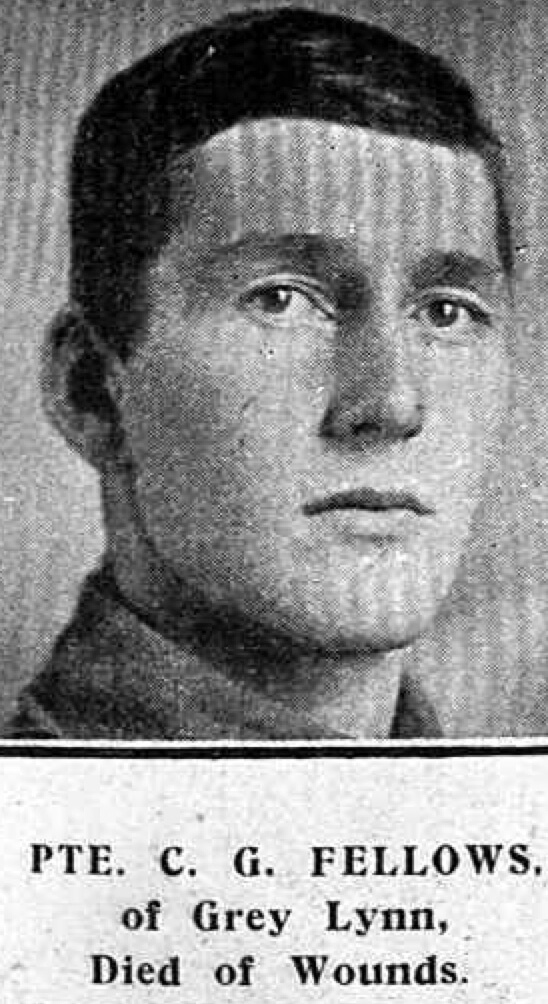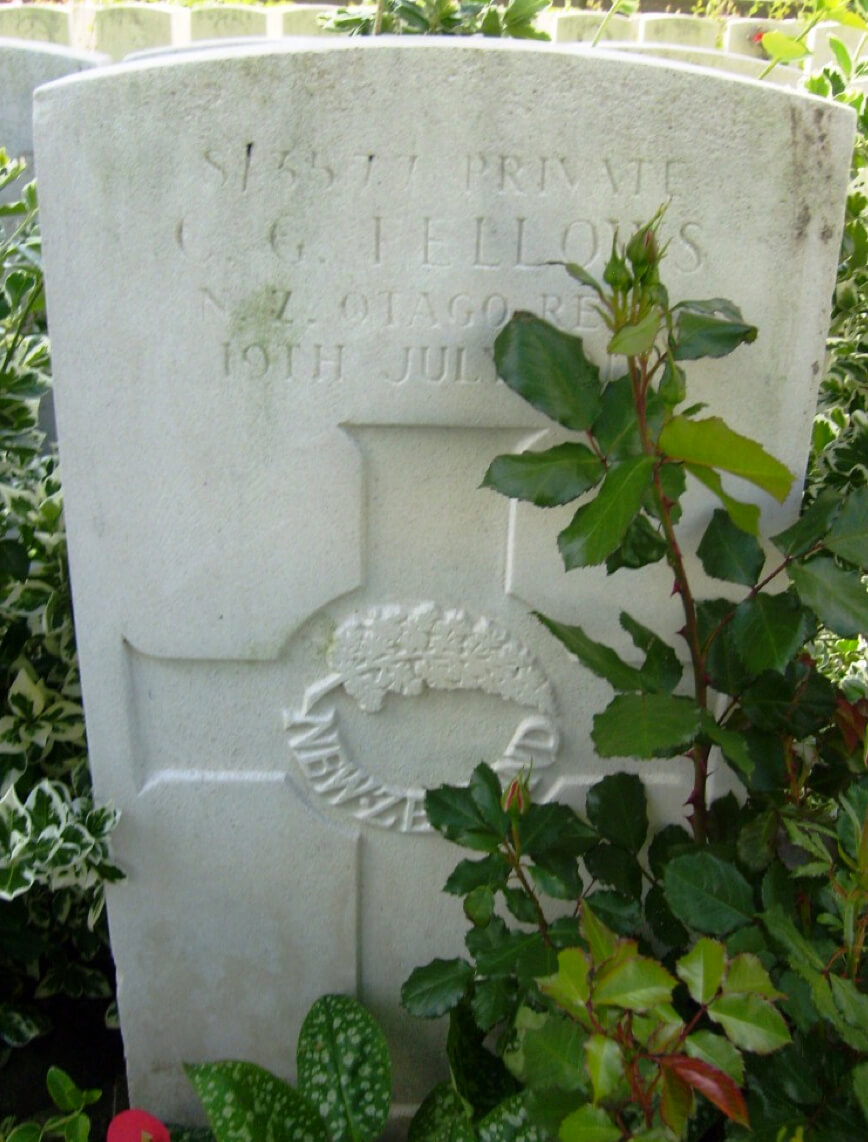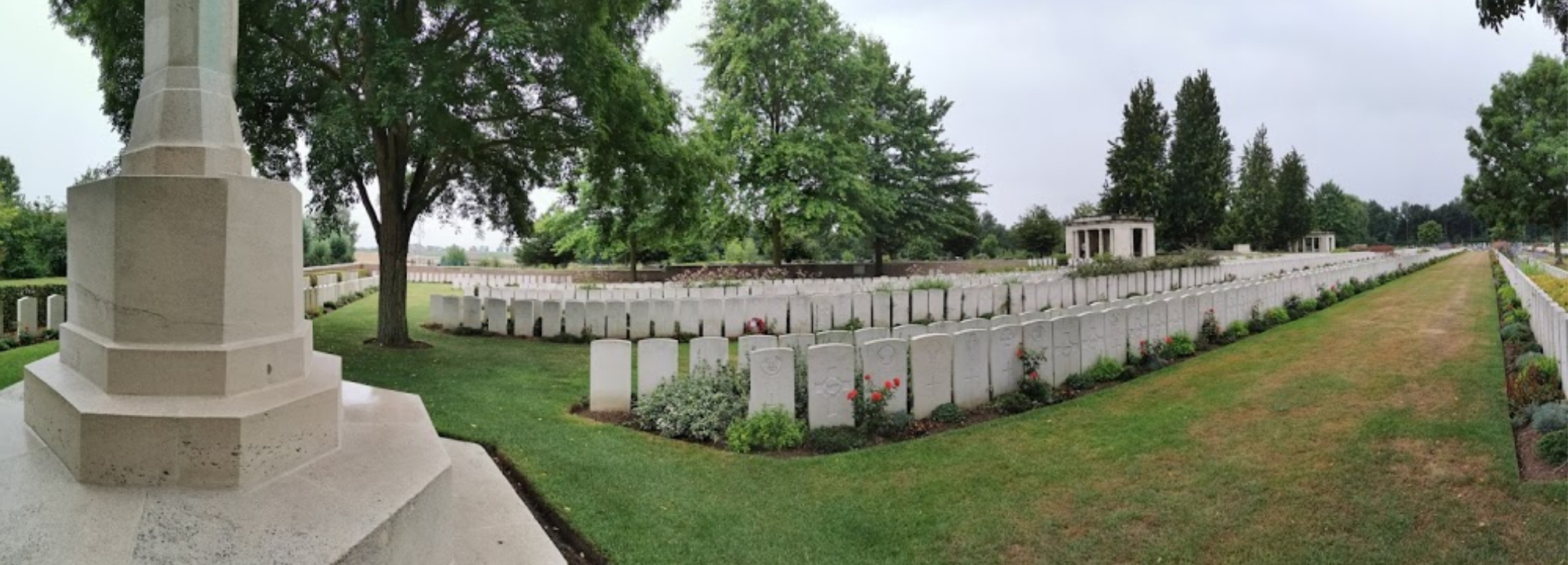Clement “Clem” George FELLOWS
Relationship to me: Great Uncle (paternal)
Clem was born on May 30th, 1897, in Onehunga to Robert FELLOWS and Rose HENRICKSEN. He was employed as a boilermaker. He went to fight in WWI and died in France on July 19th, 1916 at just 19 years old, less than a year after enlisting.
In his military records (military service number 8/3577), Clem was noted as being part of the Otago Regiment and being 5 foot 9 1/2 inches with dark hair and grey eyes and having a large brown mole on his left leg. At the time of enlisting, Clem was working as a boilermaker for H. Bach Nelson in Auckland.

After enlisting on October 28th, 1915, Clem was sent to Suez, disembarking on 14 February, 1916. In April 1916, he embarked on the HMHS Llandovery Castle, a Canadian hospital ship that also moved soldiers during the war, from Alexandria to France. In May, he was punished for being drunk on parade and docked seven days pay. Less than two months later he was wounded and died the following day. Clem is buried at the Bailleul communal cemetery.
HMHS Llandovery Castle
In 1918, HMHS Llandovery Castle was travelling from Nova Scotia to London when it was torpedoed off the southern coast of Ireland by a German submarine. There was a tragic loss of life including 234 doctors, nurses, medical corps, soldiers and seamen who drowned. Many people, including nurses managed to get into lifeboats, but the submarine then attacked them with machine guns. The only survivors were 24 people who managed to escape in a single life raft. One of the soldiers, Sergeant Arthur Knight, who was initially in a lifeboat with many of the nurses recalled the desperation as they were trying to get to safety and away from the sinking ship:
Our boat was quickly loaded and lowered to the surface of the water. Then the crew of eight men and myself faced the difficulty of getting free from the ropes holding us to the ship’s side. I broke two axes trying to cut ourselves away, but was unsuccessful. With the forward motion and choppy sea the boat all the time was pounding against the ship’s side. To save the boat we tried to keep ourselves away by using the oars, and soon every one of the latter were broken. Finally the ropes became loose at the top and we commenced to drift away. We were carried towards the stern of the ship, when suddenly the Poop deck seemed to break away and sink. The suction drew us quickly into the vacuum, the boat tipped over sideways, and every occupant went under.
Unflinchingly and calmly, as steady and collected as if on parade, without a complaint or a single sign of emotion, our fourteen devoted nursing sisters faced the terrible ordeal of certain death–only a matter of minutes–as our lifeboat neared that mad whirlpool of waters where all human power was helpless. I estimate we were together in the boat about eight minutes. In that whole time I did not hear a complaint or murmur from one of the sisters. There was not a cry for help or any outward evidence of fear. In the entire time I overheard only one remark when the matron, Nursing Matron Margaret Marjory Fraser, turned to me as we drifted helplessly towards the stern of the ship and asked: “Sergeant, do you think there is any hope for us?” “I replied, ‘No,’ seeing myself our helplessness without oars and the sinking condition of the stern of the ship. A few seconds later we were drawn into the whirlpool of the submerged afterdeck, and the last I saw of the nursing sisters was as they were thrown over the side of the boat. All were wearing lifebelts, and of the fourteen two were in their nightdress, the others in uniform. It was doubtful if any of them came to the surface again, although I myself sank and came up three times, finally clinging to a piece of wreckage and being eventually picked up by the captain’s boat.
Given that it was recognised that firing against a hospital ship was against international law, this attack on the ship was considered to be a war crime and was prosecuted in the Leipzig trials. Three officers on the submarine were prosecuted. Two were found guilty but overturned their convictions on appeal as they were found to be acting on the orders of their commanding officer. The commanding officer (the third person prosecuted) had escaped to Danzig that was not under the jurisdiction of the trials and was never prosecuted. There were many people who took exception to these trials as the Allied Forces were only prosecuting German officers and not applying the same standards to their own soldiers who had committed similar crimes.
The Otago Regiment
The Otago Regiment was formed in 1914 and originally consisted of men from Otago and Southland. Some of the soldiers who enlisted in this regiment never saw active service as they were sent to a military hospital on Quarantine Island in Otago harbour – a hospital that treated sexually transmitted diseases which was an ongoing and serious problem among the active soldiers. The Otago Regiment initially fought in Gallipoli. In early 1916, they were moved to the Western Front in France.

Clement George FELLOWES
b. 30 May, 1897 in Onehunga, Auckland, NZ
d. 19 Jul, 1916 in France
Mother: Rose Ann Adelaide Henricksen
Father: Robert Thomas Fellows
Siblings:
Arthur Russell
Tui Laurel Victoria
Irene Iris Graham
Eileen Lilac
Rose Rewa
Robert Trevor


